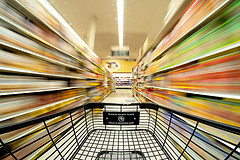Here’s How Stores Get You To Buy Stuff Using A Sensory Bombardment
You walk into a store, determined to just buy the one thing you need, the thing you came there for. Your resolve is unwavering, your spirits high — and then you’re bombarded by a slew of sensory shopping cues designed to get you to shop your little heart out. Any retailer worth its weight in marketing gold knows a few tricks of the trade, and will use them to get you to spend more if they can.
Lifehacker takes a deep dive into the world of retail sensory bombardment, with the aid of a consumer psychologist at Golden Gate University, Dr. Kit Yarrow. So how does it all work?
SIGHT
What you see is what they want you to get. And there are little symbolic clues scattered about to sway us one way or the other, including specific colors. Yarrow explains that there are some colors that have a big emotional impact, and retailers use those to evoke the right urge in shoppers. Red is usually associated with sales, because it inspires people, gets them going — essentially lights a fire under your butt to buy stuff.
“If Target’s logo was blue, it wouldn’t be perceived as a place where things are reasonably priced,” he explains. “I think value-oriented stores tend to have logos with red, but it could also be orange. Black is almost always associated with higher prices and luxury.”
Another tactic using your sight is also kind of a physical manipulation: Stores will often put stuff in your way so that you have to at least pass by it on your path to get what you really want. That’s why milk is usually in the back of the grocery store. Retailers are hoping you’ll grab a couple other items while you’re there just for one thin.
TOUCH
Research has shown that if you touch something, you’re probably more likely to buy it. As such, stores will put things where you’re likely to pick them up, and feel comfortable doing so. This means displays that don’t look too perfect, because otherwise you might be nervous about messing it up and so won’t touch it. That’s why there are sometimes buckets filled with items or a somewhat cluttered shelf with options to pick through.
Putting things on the center of a display also seems to create a sort of magnetic pull for shoppers — if it’s in the middle, we’re going to want to buy it more.
All this explains that yucky feeling of being in a store that’s too cool for school and leaving empty-handed. If a hoity-toity establishment doesn’t have things out for you to touch, it might make you less inclined to buy them, at least on a whim.
SMELL
Yarrow offers up an interesting example of how what you smell and where you smell it while shopping could influence your decisions.
“Our senses bypass our conscious mind. So, we smell something like baby powder, we feel all warm toward babies, we just happen to be in the baby department, and we spend a little more money,” he says (or maybe a single tear trickles down your face as you imagine a wee one of your own. Ahem). “Or we smell coconut and we suddenly get beach fever.”
Other stores actually pipe in signature scents into their stores, all in an attempt to affect our mood or perhaps call up the right memory that makes us happy and ready to shop. The right scent can also influence how we perceive a product’s quality. Clearly, a stores smelling of dung isn’t going to conjure up that kind of image, but the scent of say, “light accents of fruits and citrus with a hint of cocoa fill[ing] the top note before a green floral heart of gardenia, jasmine and muguet over a foundation of vanilla, sandalwood, cedarwood and amber” as piped in at Hugo Boss can go a long way.
HEARING
Anyone over the age of 19 who’s ever stepped inside an Abercrombie & Fitch, only to be blasted by thumping, pumping music knows about this one. Depending on the target demographic, stores will play different music for that set. A mall store catering to teens will likely trot out the pop music, while a fancy jewelry store is going to be more inclined toward classical music.
Another possibility is faster music is played in stores where the idea is to get people moving through it quicker, while slower, quiet music causes shoppers to linger.
It’s not like you’ll be able to tune out all these sensory clues, but at least if you find yourself buying a jumbo pack of brightly-colored plastic cups when all you wanted was a gallon of milk, you’ll know why.
How Stores Manipulate Your Senses So You Spend More Money [Lifehacker]
Want more consumer news? Visit our parent organization, Consumer Reports, for the latest on scams, recalls, and other consumer issues.


